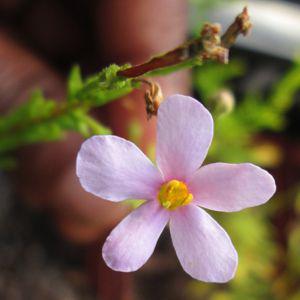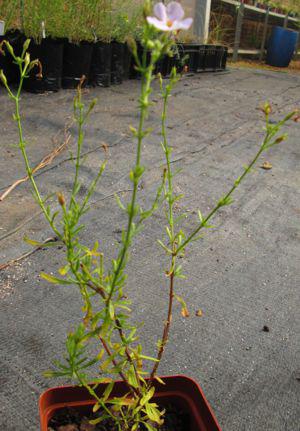Chaenostoma uncinatum
Chaenostoma uncinatum (Desr.) Kornhall
Family: Scrophulariaceae
Common names: fineleaf skunkbush (Engl.); bosopslag (Afr.)
Introduction
This is an attractive small shrub, with small dark green leaves and pretty mauve flowers in winter.

Description
Description
Chaenostoma uncinatum is a small shrub which can reach height of 600 mm, with narrowly winged branches and with short shoots in leaf axils. The leaves are elliptic, coarsely hairy, with the base running down the stem as a wing. The leaves are in groupings of three.

The star-shaped, mauve flowers with an orange tube, are loosely grouped at the tip of the stems, or at the end of branches. Flowers are 10 mm long, with 4 anthers of which two anthers protrude beyond the tube and 2 are enclosed within the tube, with the stigma also protruding. Flowering of bosopslag is normally from May to October.

Conservation Status
Status
Chaenostoma uncinatum is classified as LC (Least Concern).
Distribution and habitat
Distribution description
C. uncinatum appears to be restricted to the southwestern Cape from Gifberg to Bonnievale. It is normally found on sandy flats or rocky slopes and habitually near the coast. It is a winter rainfall plant and requires less water in summer months. It will do well in a water-wise garden.
Derivation of name and historical aspects
History
Chaenostoma is derived from the Greek words Chaino meaning ‘to gape’ and stoma meaning ‘mouth’, thus meaning gaping mouth.
The specific epithet, uncinata, meaning ‘hooked’ possibly refers to the coarse gland-tipped hairs that cover the plant.
Chaenostoma belongs to the family Scrophulariaceae in a genus of 418 species in the Cape Flora. Worldwide it has ± 4 000 species. Scrophulariaceae is the sixth largest family in the Cape Flora; it is well represented across Africa. There seems to be some controversy about how many species there are in this genus. Ninety one species across the globe are mentioned, but of these only 46 are accepted species names.

Growing Chaenostoma uncinatum
Grow
C. uncinatum will do well if planted in well-drained soil in a sunny or even semi-shaded position. It can be used in a water-wise garden in winter-rainfall climates, but it will require watering in winter in summer-rainfall climates. It is easy to propagate and responds well to light pruning.
Propagate C. uncinatum from seed or cuttings. Sow seeds in autumn in a mixture of river sand and fine bark. Cuttings can be taken in summer. It roots quickly from apical cuttings taken from new growth. Keep cutting material moist throughout, and treat with a rooting hormone. Place in the mist unit. Rooting will occur within two to three weeks. Harden off in a shade house, after which plants can be moved to areas in full sun.
References
- Brickell, C. 1989. Royal horticultural Society Gardener’s Encyclopedia of plants & flowers. Dorling Kindersley Limited, London.
- Goldblatt, P. & Manning, J. 2000. Cape Plants. A conspectus of the Cape flora of South Africa. Strelitzia 9. National Botanical Institute, Pretoria & Missouri Botanical Garden, Missouri.
- Manning, J.C., Goldblatt, P. 1996. West Coast. South African Wild Flower Guide 7. Botanical Society of South Africa, Cape Town
- Stearn, W.T. 1992. Stearn’s Dictionary of Plant Names for gardeners. A handbook on the origin and meaning of the botanical names of some cultivated plants. Cassell, UK.
- Latin and Greek Meanings and Derivations: http://www.calflora.net/botanicalnames/pageU.html. Accessed 04/05/2015.
- The Plant List A working list of all plant species. http://www.theplantlist.org/browse/A/Scrophulariaceae/Chaenostoma/. Access 04/05/2015
Credits
Zoleka Maphanga
Kirstenbosch Garden/MSB
May 2014
Plant Attributes:
Plant Type: Shrub
SA Distribution: Western Cape
Soil type: Sandy
Flowering season: Autumn, Winter
PH: Acid
Flower colour: Mauve/Lilac
Aspect: Full Sun
Gardening skill: Easy
Special Features:
Horticultural zones








Rate this article
Article well written and informative
Rate this plant
Is this an interesting plant?
Login to add your Comment
Back to topNot registered yet? Click here to register.